Hey traders, have you ever spotted a hammer candlestick on your chart and wondered, “Is this the start of a major reversal or just a pause in the trend?” If so, you’re in the right place! Let’s dive deep into the hammer candlestick pattern, understand its psychology, and explore powerful strategies to trade it effectively. Ready? Let’s go!
Introduction to the Hammer Candlestick Pattern
The hammer candle is one of the most powerful and widely recognized candlestick patterns in trading. It serves as a crucial signal in price action analysis, often indicating either temporary strength or the potential for a longer-term trend reversal.
No matter the market or time frame, spotting a hammer candle can provide valuable insights into market sentiment and trader psychology. But how do we identify a true hammer candle, and more importantly, how do we trade it profitably? Let’s break it down!
Five Point Checklist to Identify the Hammer Candlestick Pattern
First things first, what does a hammer candlestick look like? Here’s a simple five-point checklist to identify one:
- Prevailing trend is downtrend
- The candle has a small body
- The wick at the bottom must be big compared to the body (usually in a 2:1 ratio)
- At the top, it should have no wick, or a very small one
- The color of the body doesn’t matter
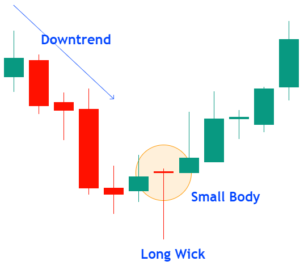
Seems easy enough, right? But why does this pattern form in the first place? That’s where price action comes into play.
What does a hammer candlestick indicate in the stock market?
Price Action: A Sign of Strength
Each candlestick on a chart represents price action over a specific time period, with every candle forming its own price range. A higher timeframe candle is essentially a combination of multiple lower timeframe candles, aggregating their price movements.
To truly understand the structure and significance of a higher timeframe candle, switch to a lower timeframe chart and examine the individual candles within the same period. This approach helps eliminate doubts and provides deeper clarity on market behavior.
Now, if we break a hammer candle down into two lower timeframe candles, what would it look like?
Let’s analyze:
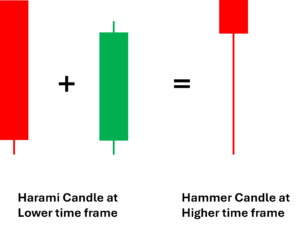
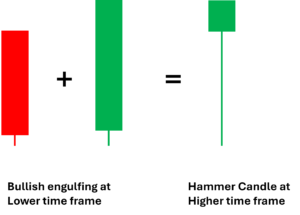
A hammer candle forms when the price initially drops within a session but then reverses, rallying to close near or above its opening price. This tells us that selling pressure was strong at first, but buyers eventually stepped in with enough force to push the price back up.
So, what do we get? A small real body near the top with a long lower wick—shaped like a hammer, quite literally “hammering out a bottom.” But does that mean we should instantly enter a trade? Not so fast!
The Psychology Behind the Hammer Candle
To truly understand the hammer, we need to think like the big players—the institutional traders, market makers, and professionals who move the market.
When the market is in a downtrend, these insiders need to exit their short positions before they can push prices higher. The hammer often signals that they are stepping in to buy, but this doesn’t mean an immediate reversal. Instead, price may climb briefly before falling again. That’s why understanding volume is key.
Hammer Candles and Volume Analysis
When analyzing charts, you may notice multiple hammer candlestick patterns appearing. But the key question is: how do you identify a high-probability reversal hammer candlestick pattern? The answer lies in volume and market context.
A hammer candle alone does not guarantee a market reversal. Instead, the volume behind the candle plays a crucial role in confirming its significance.
- Low volume: A hammer with low volume suggests minor buying interest. It may trigger a temporary bounce, but it lacks the strength to cause a major reversal.

- Average volume: This is a stronger signal of potential reversal and can present an opportunity for short-term trades.

- High or ultra-high volume: Now we are seeing significant insider buying. This is often a sign of a buying climax, where professionals are accumulating large positions in preparation for a shift in trend.

Hammer candlestick pattern in technical analysis
How to Spot a High-Probability Reversal
When analyzing price charts, you’ll often see multiple hammer candlestick patterns appear. However, not all hammers signal a true market reversal—some simply indicate a brief pause before the trend continues.
So, how do you identify a high-probability hammer reversal? The answer lies in two critical factors: volume and market context.
Whenever a hammer forms, ask yourself:
- Is this candle just a temporary pullback, or does it mark the beginning of a reversal?
- What does the volume reveal about insider activity—are they accumulating long positions or just testing the market?
- How does this hammer interact with other price action signals?
- Where is it forming within the broader market structure, particularly on higher time frames?
A hammer with ultra-high volume, especially when formed at a Higher Time Frame Support, often indicates that insiders are absorbing selling pressure and accumulating long positions, preparing for an uptrend. These signals frequently appear during accumulation phases or just before a breakout, as smart money tests whether selling pressure is exhausted before committing to a full reversal.
Recognizing the hammer in the right context can provide a significant trading edge. It’s not just about spotting the pattern—it’s about understanding the story the market is telling.
Still with me? Awesome! Now, let’s discuss how to actually trade the hammer pattern.
How to Trade the Hammer Candlestick Pattern?
Entry and Stop-Loss Strategy
Entry Confirmation:
- Identify a hammer candle at the bottom of a downtrend.
- Wait for the next candle to close above the high of the hammer.
- Enter a long position at the break of the hammer’s high.

Stop-Loss Placement:
- Set the stop-loss just below the low of the hammer candle.
- If the wick is too long, a tighter stop can be placed at the midpoint of the hammer candle if a support level confirms the entry.
Take-profit target: Aim for the next resistance level or a 1:2 risk-to-reward ratio.
Trading Strategies for the Hammer Candlestick
Strategy 1: Pullback after Breakout
As a bullish reversal pattern, the Hammer is a great pattern to watch for when the price is on an uptrend. Just wait for a pullback to start and then spot when the Hammer appears.
This often signals the end of the pullback and the start of the next upward move.
Here’s an example:
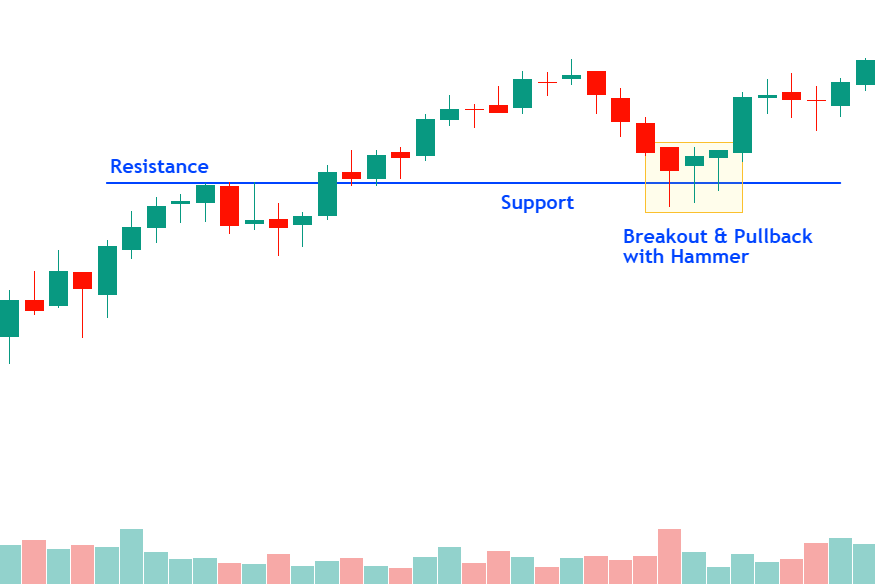
Strategy 2: Trading The Hammer with Support Levels
Support and resistance levels are great places to find price reversals. Since we are looking for moves to the upside, we want to trade the Hammer using support levels.
How does it work:
- Draw support levels on your charts
- Wait for the price to decline and hit the support level
- Check if a Hammer appears at that level
- Go long when the price breaks the high of the Hammer
- Set your stop loss and take profit levels, and expect a move to the upside
Here’s an example:
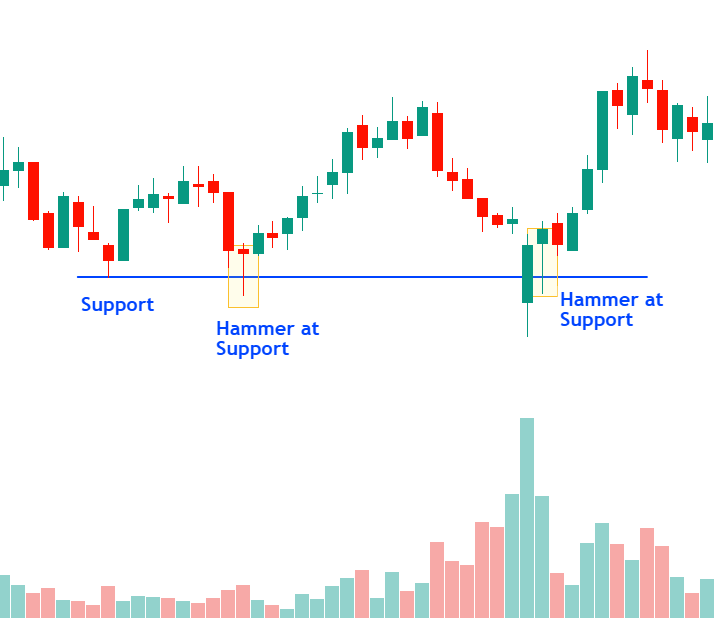
Strategy 3: Trading The Hammer with Moving Averages
Moving averages are great trading indicators to trade trends. The idea here is to trade pullbacks to the moving average when the price is on an uptrend.
How does it work:
- Find an uptrend, with the price jumping above a moving average
- Wait for a decline in the price to the moving average
- Check if a Hammer appears at the moving average
- Go long when the price breaks the high of the Hammer
- Set your stop loss and take profit levels, and expect another leg to the upside
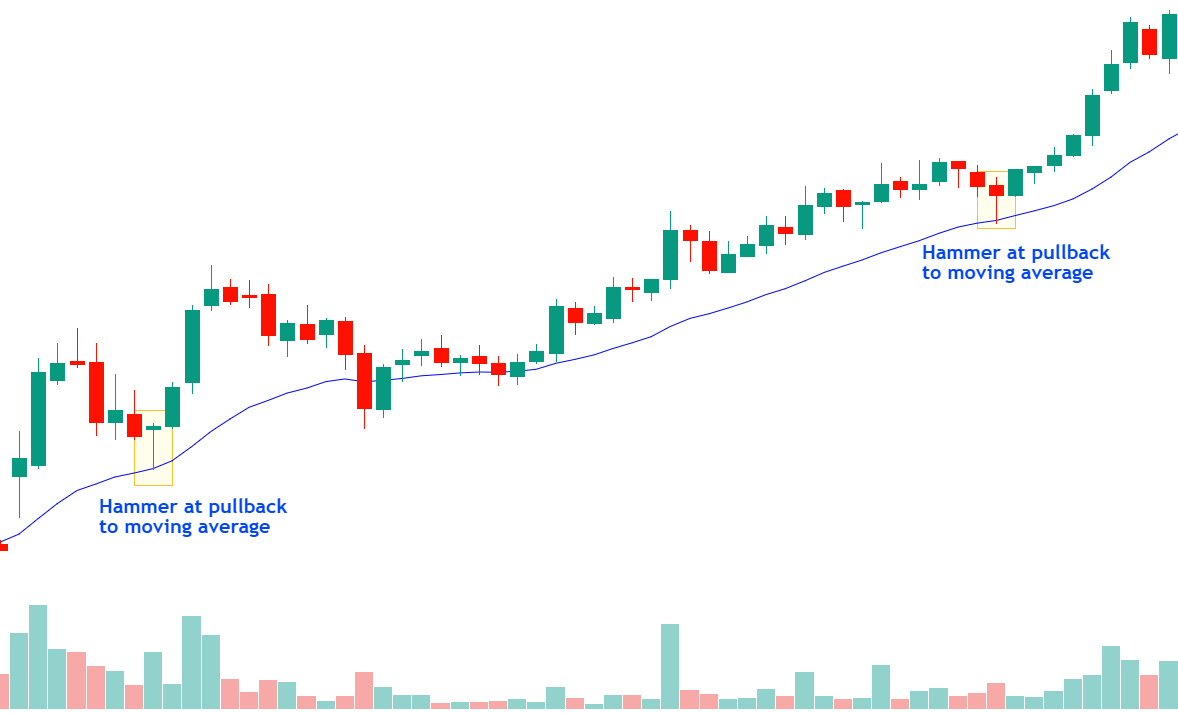
Strategy 4: Trading The Hammer with Pivot Points
Pivot Points are automatic support and resistance levels calculated using previous day High, Low, Open & Close. If you are day trading, the Daily Pivot Points are the most popular and also used by smart money.
Here’s how to trade the Hammer pattern with Pivot Points:
- Activate the Pivot Points indicator on your charts
- Check which Pivot Points are under the price, those will tend to work as a support
- Ideally, you want to see the price on an uptrend, although is not required
- Wait for a decline of the price to a Pivot Point level
- At that level, you want to see a Hammer pattern appearing, meaning that the level is being rejected
- Go long when the price breaks the high of the Hammer
- Set your stop loss and take profit levels, and expect a move to the upside
The Hammer Candle’s Role in Trend Trading
One of the hardest skills in trading is staying in a trend and not exiting too early. The hammer candle, combined with Volume Price Analysis (VPA), can help traders hold their positions with confidence.
For instance, suppose you are short in a downtrend, and a hammer candle appears. Should you close your position? If the hammer’s volume is low, the answer is likely no—there isn’t enough buying power to reverse the trend. But if it’s followed by a shooting star on high volume, this confirms continued weakness, and you can stay in your short trade.
On the other hand, if a hammer appears with ultra-high volume, this is a warning sign that big money is stepping in. It may be time to start taking profits on your short position and preparing for a potential long trade when a breakout occurs.
Conclusion
The hammer candle is a vital tool for traders, but like all signals, it must be interpreted in the context of volume and broader market action. Alone, it hints at strength; combined with volume, it reveals whether that strength is temporary or the start of a true reversal.
By mastering the hammer candlestick Pattern and Volume Price Analysis, traders can:
- Enter trades with confidence
- Stay in winning positions longer
- Avoid premature exits
Now that you understand the hammer candlestick pattern inside out, are you ready to use it in your trading?
Note: This article is part of Tradonomics’ Smart Money Secrets with Volume Price Analysis series. Explore it to unlock powerful trading insights and master Volume Price Action!
